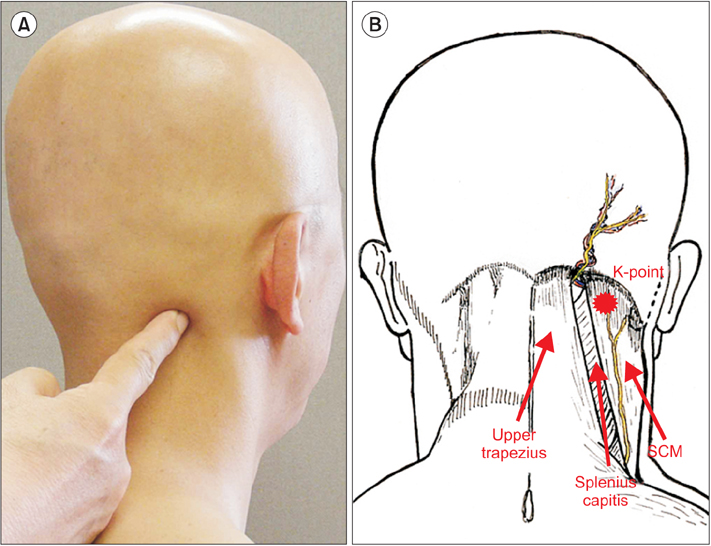Clin Orthop Surg.
2016 Dec;8(4):393-398. 10.4055/cios.2016.8.4.393.
Usefulness of K-Point Injection for the Nonspecific Neck Pain in So-Called K-Point Syndrome
- Affiliations
-
- 1Department of Orthopedic Surgery, Yeungnam University Medical Center, Yeungnam University College of Medicine, Daegu, Korea. mwahn@med.yu.ac.kr
- KMID: 2412321
- DOI: http://doi.org/10.4055/cios.2016.8.4.393
Abstract
- BACKGROUND
Shoichi Kokubun introduced his successful experience with local anesthetic injection at the occipital insertion of the sternocleidomastoid muscle in K-point syndrome. The purpose of this study was to evaluate the short-term and long-term effectiveness of K-point injection and investigate factors affecting treatment results.
METHODS
K-point injection was performed in 58 patients with K-point syndrome at Yeungnam University Medical Center. The syndrome was associated with cervical whiplash injury in 10 patients and was of nonspecific origin in the rest. One milliliter of 2% lidocaine mixed with 1 milliliter of dexamethasone was injected in 50 patients and 2 milliliters of 1% lidocaine alone in the rest. Initially, the severity of local tenderness at the K-point and other tender points was examined and the degree of immediate pain relief effect was assessed within 1 hour after injection. Early effect within 1 month after the injection and current effect were evaluated in 27 patients using a modified Kim's questionnaire with regard to the duration of improvement, degree of improvement in pain and daily living activities, and satisfaction.
RESULTS
Of the total 58 patients, 44 (75.8%) apparently had immediate pain relief after K-point injection. The only factor associated with successful immediate pain relief was the whiplash injury associated with traffic accident (TA). The early pain control effect was associated with the immediate effect. The current effect was associated with the early effect alone. Satisfaction with the K-point injection was related to early successful pain relief.
CONCLUSIONS
K-point injection would be useful for early pain relief in nonspecific neck pain syndrome so called K-point syndrome, but not for current pain relief. Especially, it was very effective for early pain control in the whiplash injury associated with TA.
MeSH Terms
-
Adult
Aged
Aged, 80 and over
Anesthetics, Local/*administration & dosage/therapeutic use
Dexamethasone/administration & dosage/therapeutic use
Female
Fibromyalgia/drug therapy
Humans
Injections, Intramuscular/methods
Lidocaine/administration & dosage/therapeutic use
Male
Middle Aged
Neck Pain/*drug therapy
Pain Management
Pain Measurement
Retrospective Studies
Whiplash Injuries/drug therapy
Young Adult
Anesthetics, Local
Dexamethasone
Lidocaine
Figure
Reference
-
1. Staud R. Peripheral pain mechanisms in chronic widespread pain. Best Pract Res Clin Rheumatol. 2011; 25(2):155–164.
Article2. Wolfe F, Clauw DJ, Fitzcharles MA, et al. The American College of Rheumatology preliminary diagnostic criteria for fibromyalgia and measurement of symptom severity. Arthritis Care Res (Hoboken). 2010; 62(5):600–610.
Article3. Kim HS, Min HJ, Yoon US, Seo JS, Kim YJ, Jo SM. Efficacy of epidural steroid injection in lumbar spinal stenosis. J Korean Soc Spine Surg. 2005; 12(4):310–315.
Article4. Foster CA, Jabbour P. Barré-Lieou syndrome and the problem of the obsolete eponym. J Laryngol Otol. 2007; 121(7):680–683.
Article5. Longbottom J. A case report of postulated 'Barré Liéou syndrome'. Acupunct Med. 2005; 23(1):34–38.
Article6. Bogduk N, Govind J. Cervicogenic headache: an assessment of the evidence on clinical diagnosis, invasive tests, and treatment. Lancet Neurol. 2009; 8(10):959–968.
Article7. Hong JP, Lai CH, Lin YC, Chou SW. Clinical assessment of patients with cervicogenic headache: a preliminary study. Chang Gung Med J. 2010; 33(1):58–66.8. Jackson R. The classic: the cervical syndrome. 1949. Clin Orthop Relat Res. 2010; 468(7):1739–1745.9. Panjabi MM. The stabilizing system of the spine. Part II: neutral zone and instability hypothesis. J Spinal Disord. 1992; 5(4):390–396.
Article10. Simons DG, Travell JG, Simons LS. Travell & Simons' myofascial pain and dysfunction: the trigger point manual. Volume 1: upper half of body. 2nd ed. Baltimore, MD: Lippincott Williams & Wilkins;1999.11. Giamberardino MA, Affaitati G, Fabrizio A, Costantini R. Myofascial pain syndromes and their evaluation. Best Pract Res Clin Rheumatol. 2011; 25(2):185–198.
Article12. Glass JM. Cognitive dysfunction in fibromyalgia and chronic fatigue syndrome: new trends and future directions. Curr Rheumatol Rep. 2006; 8(6):425–429.
Article13. Salaffi F, Sarzi-Puttini P. Old and new criteria for the classification and diagnosis of fibromyalgia: comparison and evaluation. Clin Exp Rheumatol. 2012; 30:6 Suppl 74. 3–9.14. Goldenberg DL, Burckhardt C, Crofford L. Management of fibromyalgia syndrome. JAMA. 2004; 292(19):2388–2395.
Article15. Herren-Gerber R, Weiss S, Arendt-Nielsen L, et al. Modulation of central hypersensitivity by nociceptive input in chronic pain after whiplash injury. Pain Med. 2004; 5(4):366–376.
Article16. Curatolo M, Petersen-Felix S, Arendt-Nielsen L, Giani C, Zbinden AM, Radanov BP. Central hypersensitivity in chronic pain after whiplash injury. Clin J Pain. 2001; 17(4):306–315.
Article17. Elliott JM, Noteboom JT, Flynn TW, Sterling M. Characterization of acute and chronic whiplash-associated disorders. J Orthop Sports Phys Ther. 2009; 39(5):312–323.
Article
- Full Text Links
- Actions
-
Cited
- CITED
-
- Close
- Share
- Similar articles
-
- Treatment Experience of Pulsed Radiofrequency Under Ultrasound Guided to the Trapezius Muscle at Myofascial Pain Syndrome: A Case Report
- Trigger Point Injection for the Treatment of Myofascial Pain Syndrome
- Clinical Characteristics and Effects of Pain Trigger Point Injection on Myo-fascial Pain Syndrome Patients Visiting the Emergency Room
- Ischemic Compression After Trigger Point Injection Affect the Treatment of Myofascial Trigger Points
- Myositis Ossificans of the Elbow after a Trigger Point Injection


